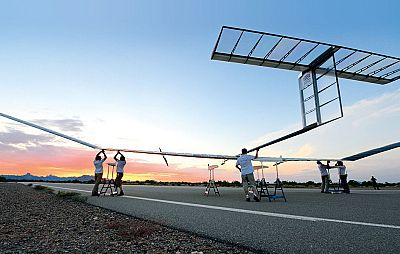Zephyr could replace some spy or Earth-observing satellites in the future.
A solar-powered drone that can stay aloft for weeks or months at a time could one day replace expensive satellites in space for certain tasks, such as monitoring the environment and snapping photos from super-high altitudes.
The latest model of the so-called Zephyr drone was revealed by Airbus last week. The drone embarked on a test flight on July 11 and has been circling high above Arizona, miles above the weather and regular air traffic, ever since. The drone is slated to land in early August.
Solar panels on the drone's wings power its electric motors and charge its batteries during the day. At night, the motors are driven by the batteries alone.
The Zephyr's 80-foot wingspan rivals a fighter jet, but it's made with ultralight carbon fiber materials that Airbus developed with Formula 1 racing team Williams. As a result, the drone weighs about 150 pounds — light enough for three people to launch by hand, said Airbus spokesman Alain Dupiech.
Airbus calls Zephyr a "High Altitude Pseudo-Satellite," or HAPS, and says the drone could perform some of the functions of orbital satellites without the high costs and high risks of launching new satellites. The price tag for a Zephyr drone is more than $5 million, reported Defense News — a significantly smaller price tag compared to orbital satellites, which can cost between $50 million and $400 million to build and launch.
Dupiech said Zephyr could fly at an altitude above 70,000 feet during the day — higher than most aircraft except military spy planes. The latest version of Zephyr was designed to fly for at least a month, but future models could stay aloft for up to four months, Dupiech said.
Science
Siddharth Shihora, an analyst at the Cambridge, Massachusetts-based space industry consulting firm Northern Sky Research, sees military customers as the main market for the Zephyr drone in the near future. Spy cameras aboard a high-flying drone can take much more detailed reconnaissance images of the ground than satellites in orbit.
But Airbus also hopes to put Zephyr to work at civilian tasks now carried out by satellites in space or piloted aircraft, such as studying broad swaths of the planet for environmental changes or monitoring wildfires and offshore oil spills.
But Shihora questioned whether high-flying drones like Airbus' Zephyr will be able to find a foothold in a competitive industry.
"There are two definitions of success — technical success and commercial success," Shihora said. "Technical success is what Airbus [has] achieved right now … but when it comes to the revenue side of things, that is a bit questionable."
He added that many civilian tasks like environmental monitoring can be carried out at less expense by very lightweight "nano-satellites," which can be launched into orbit by the dozen on a single rocket.
Still, Airbus thinks Zephyr drones could be used for high-flying services that don't yet exist, such as airborne internet connectivity for users on the ground.
A 2018 report by Northern Sky Research estimated that the military and civilian market for HAPS like high-altitude drones, balloons and airships could be worth $1.7 billion over the next 10 years.
Shihora and some other analysts, however, think high-altitude balloons like Google's Project Loon will take the largest share of the airborne internet connectivity market.
Drone-based internet services will also face competition from orbiting constellations of internet satellites, such as those being trialed by Elon Musk's SpaceX.












